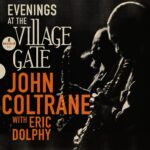Elvin Jones’ drums cascade and crash like showers of summer rain sizzling on Bleecker Street blacktop. Eric Dolphy’s flute floats into frame, then cedes to John Coltrane’s soprano- the lark giving way to the hawk- as Trane circles the familiar theme of “My Favorite Things.” Instantly we’re back in NYC, in August of ’61, when Coltrane and his then-quintet were holding court in the darkened recesses of a subterranean Greenwich Village kingdom.
Trane was a king-in-transition; slipping away from Miles Davis, basking in the unexpected, crossover hit of the aforementioned sugary pop show-tune from “The Sound of Music” he’d reconfigured as a modal monster, and beginning a relationship with the Impulse! label that would produce some of the most influential, instrumental tectonic shifts ever.
So, too, was Coltrane reshaping his trusted quartet into a quintet- on the fly, essentially- welcoming old friend, Dolphy, for many of those hot August nights, or pairing the Quartet’s bassist, Reggie Workman, with a second bass from Art Davis, all circumnavigated by McCoy Tyner’s dexterous, dancing piano. Guests would sit-in, as well, throughout the run, but the five tracks here- from recordings initially made to test the Gate’s new sound system, and rescued from the archives of the New York Public Library- are reserved to those six players. And they are beasts to behold-each eclipsing the 15-minute mark- these cerebral mazes of intended mania that wrap tightly around the rules and rudiments of jazz and then set them all aflame.
“Impressions” and “Africa,” two Coltrane originals, fittingly, announce his Impulse! era and are the album’s pinnacle performances in both sonic balance and sheer ferocity. Yet, really, it’s all exceptional and vital and necessary for any serious fan of music- the sparkling renditions of “When Lights Are Low” and “Greensleeves,” too, hypnotize- and thank goodness they were resurrected. As with any Coltrane recording, it’s no less than historic- he’s just that important- as Evenings at the Village Gate encapsulates Coltrane’s August 1961 residency in awe-inspiring fashion, and adds wonderfully to Trane’s already-immense legacy.



No Comments comments associated with this post